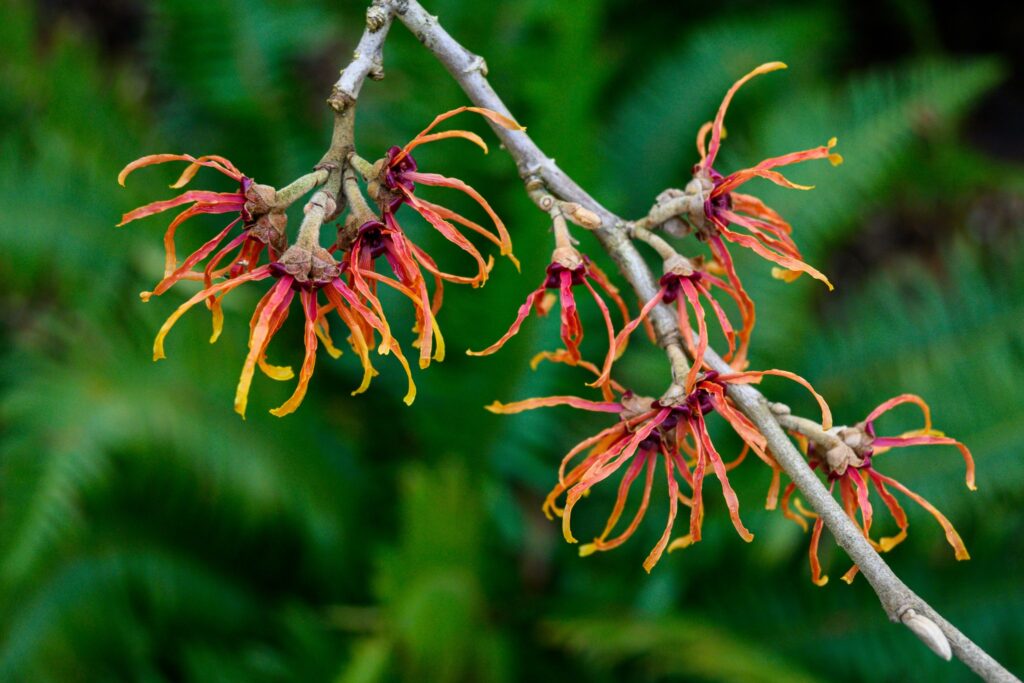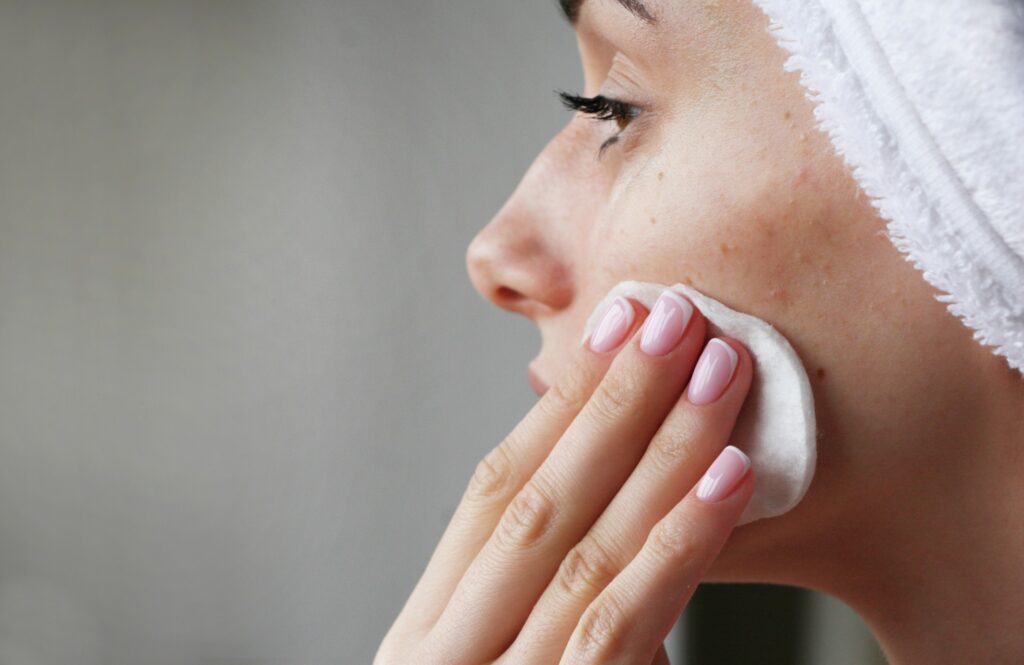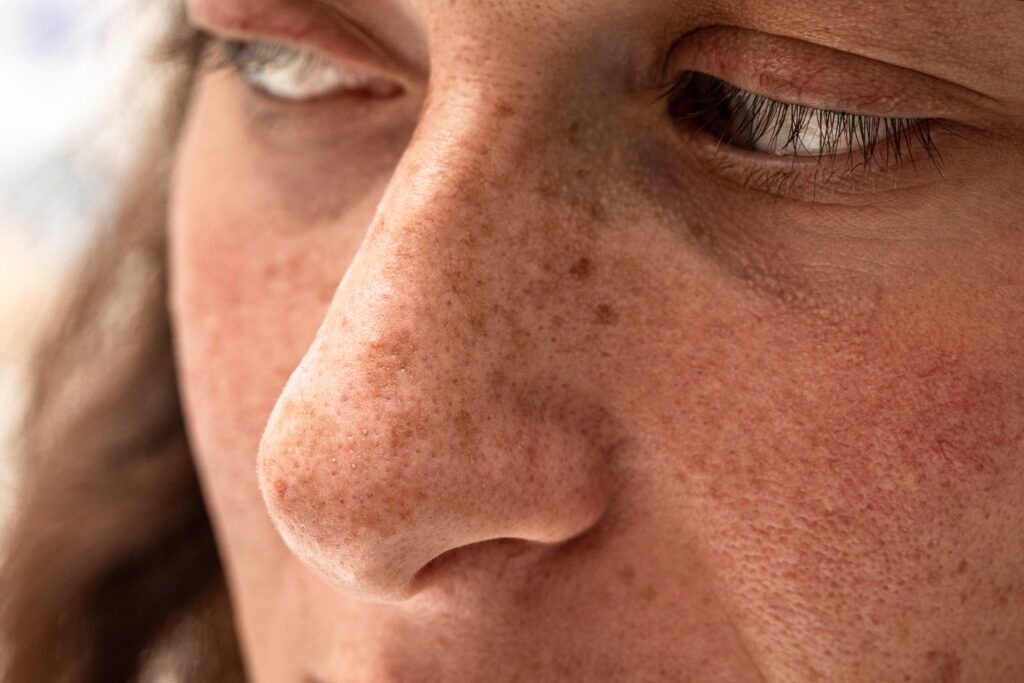Many Americans know witch hazel as an astringent they can grab off the shelves of their local drugstore or find as an ingredient in their favorite skincare products. But very few know what it is or why it works so well. There is a long history of using witch hazel for skin support, so let’s get to know this fascinating plant.
The Ancient Witch Hazel Plant
Hamamelis virginiana, commonly known as witch hazel, has a long history in folk medicine and other practices. Lore from the Appalachian Mountains recalls the plant being used for a wide range of ailments including sore muscles and burns. Witch hazel also factored into rituals as a way to ward off evil spirits and broken hearts. (1)
Witch hazel is a unique plant because it flowers during the winter rather than spring or summer. Gardeners and landscapers love this plant for the pop of color it provides during the gloomy winter months.
Typically growing up to 15 feet tall, witch hazel is sometimes classified as a large shrub and other times as a small tree. It’s a deciduous plant with strappy-looking yellow or orange flowers, native to the eastern United States and Canada. (2) Additionally, there are two varieties native to Japan and Asia. (3)
One interesting fun fact about this plant is that people used to believe it had divining powers for finding underground water. Indigenous groups and settlers in the Americas would use a forked branch to seek water sources. Some say that its name comes from this practice of “water-witching.” (4)
Other sources say the name comes from the Old English words “wice” or “wiche,” meaning bendable or pliant. The process of “water-witching” involved watching for the branch to bend toward the ground to indicate the presence of water. (3)
In addition to its purported ability to find water, witch hazel has a long tradition as a healing plant. Indigenous groups from New York to Michigan used the plant’s bark and leaves for many medicinal purposes including (5):
- Skin Irritations
- Arthritis
- Respiratory Conditions
- Hemorrhoids
- Bruises
- Insect Bites
- Toothaches
Witch Hazel Preparation
The traditional preparation involved steaming the bark and small branches under pressure to extract the hydrosol distillate. (3) The Potawatomi in Michigan also placed witch hazel branches on hot rocks in their traditional sweat lodges to help ease sore, aching muscles. (1)
First Commercial Use
As happened throughout the Americas, settlers and colonizers arrived and witnessed how indigenous groups used the witch hazel plant. In the 1840s, a pharmacist named Theron Tilden Pond developed a topical ointment after watching an Oneida healer use the plant to treat burns and cuts. In 1846, this became the first known commercial product using witch hazel. (5)
Benefits of Witch Hazel for Skin Health
Witch hazel continues to be a popular and useful ingredient in skincare products because it helps to support healthy skin.
Here are some of the top benefits witch hazel can offer in your skincare routine.
1. Reduces Inflammation
Topical application for skin ailments was one of the primary uses of witch hazel throughout indigenous communities. So it makes sense that this is still how we often use the plant.
Witch hazel contains tannins and gallic acid, both of which have strong anti-inflammatory properties. (6) (7) With these components present in the plant, witch hazel can be helpful in soothing sunburns and other skin conditions such as acne (8) or eczema. (9)
Product to try: Fountain of Youth Skincare’s Rewind Serum uses witch hazel and other beneficial ingredients that help to soothe the skin.
2. Reduces Appearance of Pores
Witch hazel is a natural astringent, which means that it draws some oil and water out of the skin. This process helps large pores close up a bit to appear smaller. It also can help prevent acne flareups by reducing excess oil in the pores and taking advantage of the tannins’ anti-inflammatory properties. (8)
Product to try: Fountain of Youth Skincare’s Clear Toner uses witch hazel to help tone, tighten, and balance the skin.
3. Prevents Aging from Sun Damage
It’s well-known that sun damage is one of the biggest contributors to prematurely-aged skin, or photoaging. (10) The antioxidant polyphenols in witch hazel help the plant protect our skin from this type of damage. (11)
Polyphenols are plant-based compounds that help stop free radicals from causing cellular damage. (12) We frequently hear about polyphenols when health experts tout the benefits of consuming dark chocolate and red wine. When used topically, witch hazel can help counteract the negative effects of the sun’s UV rays. (11)
Product to try: Fountain of Youth Skincare’s Dream Serum uses witch hazel and other plant-based ingredients with potent antioxidant benefits.
4. Soothes Under-Eye Puffiness
The calming and anti-inflammatory properties of witch hazel make it an ideal choice for the skin under your eyes. Our under-eye skin is some of the thinnest on our bodies, so it can become swollen and puffy very easily. As an astringent, witch hazel helps pull out the excess water that may accumulate under the eyes while we are sleeping. (13)
Product to try: Fountain of Youth Skincare’s Rewind Eye Cream helps protect your under-eye skin and helps to relieve uncomfortable puffiness.
Ancient Healing for Your Skin
At Fountain of Youth Skincare, we seek out the highest quality ingredients inspired by Mother Earth to help you enjoy healthy, radiant skin. Several of our toners and serums rely on this beautiful plant, and we think you’ll love the results.
Sources:
- Mary Plantwalker. “The Folklore and Medicine of Witch Hazel.” Chestnut School of Herbal Medicine. Published online May 2022.
- The University of Texas at Austin. “Hamamelis virginiana.” Published online 2017.
- The University of Arkansas System Division of Agriculture. “Plant of the Week: Witchhazel.” Published online December 2012.
- Haverford College. “The Wonders of Witch Hazel.”
- Gayle Engels and Josef Brinckmann. “Witch Hazel, Hamamelis virginiana, Family: Hamamelidaceae.” American Botanical Council. Published online 2017.
- B H Kroes, A J van den Berg, H C Quarles van Ufford, H van Dijk, R P Labadie. “Anti-inflammatory activity of gallic acid.” National Library of Medicine. Published 1992 December. doi: 10.1055/s-2006-961535.
- M.L.R.Mota G.Thomas, J.M.Barbosa Filho. “Anti-inflammatory actions of tannins isolated from the bark of Anacardwm occidentale L.” Published July 1985 doi: 10.1016/0378-8741(85)90074-1
- Philip D. Shenefelt. “Herbal Treatment for Dermatologic Disorders.” National Library of Medicine. Published 2011.
- Zoe Diana Draelos, Stanley B Levy, Celeste Lutrario, Hemali Gunt. “Evaluation of the Performance of a Nature-Based Sensitive Skin Regimen in Subjects With Clinically Diagnosed Sensitive Skin.”
- Yale Medicine. “Photoaging (Sun Damage).”
- Juliane Reuter, Ute Wölfle, Hans Christian Korting, Christoph Schempp. “Which plant for which skin disease? Part 2: Dermatophytes, chronic venous insufficiency, photoprotection, actinic keratoses, vitiligo, hair loss, cosmetic indications.” National Library of Medicine. Published 2010 November. doi: 10.1111/j.1610-0387.2010.07472.x.
- F Afaq, S K Katiyar. “Polyphenols: skin photoprotection and inhibition of photocarcinogenesis.” Published 2011 December. doi: 10.2174/13895575111091200.
- Tamsyn SA Thring, Pauline Hili, and Declan P Naughton. “Antioxidant and potential anti-inflammatory activity of extracts and formulations of white tea, rose, and witch hazel on primary human dermal fibroblast cells.” National Library of Medicine. Published 2011 October 13. doi: 10.1186/1476-9255-8-27





